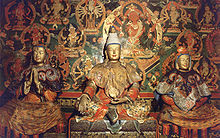Bhrikuti
Bhrikuti ( Tib . : bal mo bza khri btsun ; also: lha gcig bza khri btsun ) was , according to Tibetan tradition, a princess from the Nepalese kingdom of Licchavi , daughter of King Aṃshuvarmā . She is said to have been married to King Songtsen Gampo alongside Wen Cheng in the 7th century AD . According to tradition, Bhrikuti - also known as "Besa" - was a staunch Buddhist . In iconography it is mostly represented as an aspect of the green tare .
Buddha aspect
According to tradition, Princess Bhrikuti is said to have been heavily involved in the spread of Buddhism in Tibet. In the center of Tibet's capital Lhasa , she founded the Johkang Temple.
Bhrikuti , the yellow liberator , also goddess of the frown (Tibetan: Tonyer Tschenma; Sanskrit: Vasudhārā) is a Buddha aspect.
According to legend, she was born from a frown of Avalokiteshvaras / Chenrezig and she embodies the aspect of hot temper. Often she is also considered the emanation of Amitabha , in both peaceful and wrathful aspects.
While she is considered a Bodhisattva in Japan , she stands for the wrathful aspects of the green tara in Tibetan Buddhism .
Her mantra is:
- OM tare tuttare ture pushtim kuru OM
Followers of Tibetan Buddhism are warned against using mantras if the practitioner has not yet received the appropriate initiation or authorization. That is why these mantras are only mentioned and practiced with them during the ritual initiations.
As is customary in Tibetan Buddhism, it is only passed on from a lama through lung or initiation . In Tibetan Buddhism, only mantras of Buddha aspects from the lotus family are freely passed on without initiation or authorization. That is why mantras are usually only mentioned and practiced with the ritual initiations.
presentation
Bhrikuti is shown with a yellow body color, one or more heads and with up to eight arms. Her main attributes are kalasha, trident and mala . Mostly it has one head and four arms; the ones on the right hold a lotus flower and a rose branch, the left a trident and a vase. She has the vertical wisdom eye on her forehead.
- She is represented as Khadivarani-Tara sitting, her hands holding the stem of a blue lotus,
- as a vajra-tara with four heads and eight arms she holds vajra , arrow, conch shell, lotus, bow, elephant skin and mala,
- and as Janguli-Tara with three heads and six arms, she only holds tantric symbols in her hands.
literature
- Mallar Ghosh: Development of Buddhist Iconography in Eastern India. A study of Tara, Prajnas of five Tathagatas and Bhrikuti . New Delhi: India Munshiram Manoharlal Publishers Pvt. Ltd., 1980, 218 pages with 54 illustrations, ISBN 81-215-0208-X
